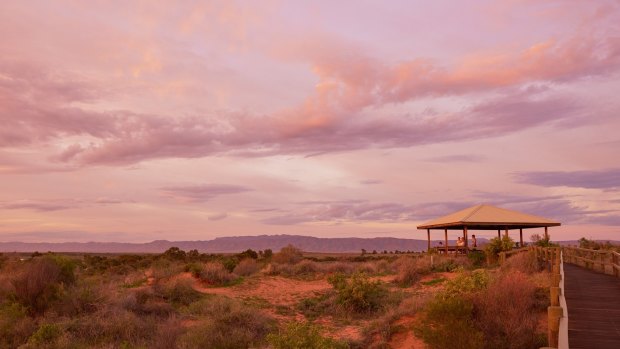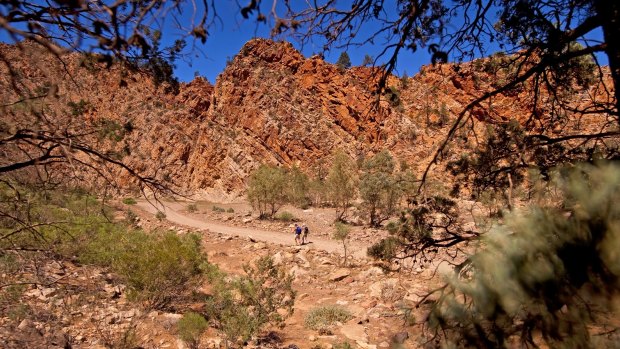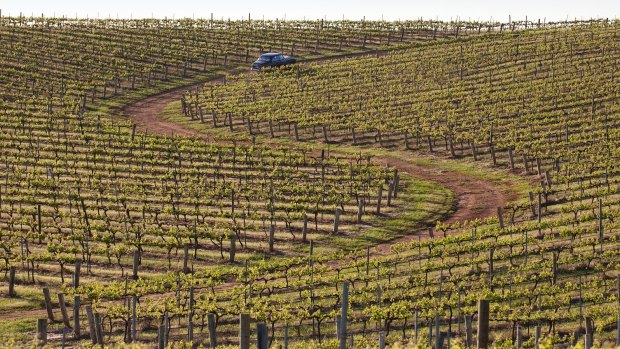This was published 8 years ago
Explorer's Way: Best off-the-beaten-track in South Australia
By Max Anderson

Dusk: The landscape at Arid Lands Botanic Garden.Credit: Adam Bruzzone
SPONSORED ARTICLE
The night before setting out on the Explorer's Way, I recommend a glass of Scotch in The Treasury bar on Victoria Square in Adelaide.
The bar is just across the road from a statue of John McDouall Stuart, the indomitable Scottish explorer who finally crossed our mighty continent after not one but six attempts.

Shades of ochre...Hiking through Parachilna Gorge.Credit: Matt Nettheim
Never shy of a drink, Stuart would doubtless have joined in raising a toast to the trip ahead of you – a 3020km drive from Adelaide to Darwin, or to put it another way, a journey that's akin to driving from Stockholm to Madrid.
Adelaide is the city from where Stuart set out on his final expedition in 1861 before reaching Point Stuart on the Arafura Sea nine months later. His achievement would open the interior to the European pastoralists and usher in profound changes, not least for the indigenous peoples (who would suffer greatly) and the native ecology (which would be radically reshaped by feral species and the removal of the dingo).
The Explorer's Way is remarkable for just how much of the route follows in Stuart's footsteps, transitioning from a coastal Mediterranean climate in the south, through arid desert landscapes in the centre to the tropical climes of the high north. The South Australian portion of the Explorer's Way pushes through what was the greatest barrier to the earlier pioneers, the deserts and vast salt pans, as well as the cruel irony of country that would flood in winter and desiccate in summer.

On the road... On the way to Sevenhills Cellars.Credit: Vanessa Size
Once Stuart's map was complete (and importantly marked with the precious desert springs that the Aboriginal people had known for millennia), he was followed by the telegraph lines, the railway lines, the railway towns, and eventually the bitumen highway that now carries his name all the way to Darwin.
Thanks to Stuart, your crossing is not only considerably easier, you also have choices in how you experience this, one of the world's great drives.
The smartest way to travel is to afford yourself that most precious of commodities — time. Travellers who get obsessed with covering the distance (you can theoretically do it in 2 ½ days) inevitably reduce the experience to a string of roadside cafes and overnight rest stops, which is a rather joyless way of missing out on some of this county's most extraordinary sights.
Far better to break the journey and linger at the waypoints – give each of those listed below at least a day and possibly a night. Take the time to soak up the histories, explore the landscapes and meet the remarkable people who make their lives in isolated and sometimes extreme environments.
If you're sticking strictly to the Explorer's Way, you'll have bitumen and fuel stops the whole way and a two-wheel drive will suit perfectly. If however you wish to take some of the off-road outback detours (not least the brilliant Oodnadatta Track) you will want to think hard about your vehicle (four-wheel drive is preferable) your provisions, and the time of year you're travelling.
I recently did a 10-day trip in January and had 45C the whole way; winter can likewise bring weather issues, not least road-closures through rain.
Here are the South Australian stages of the Explorer's Way. Think of them as dots: join them together and you'll see the bigger picture.
Adelaide to Clare Valley, the start of the Explorer's Way
Driving time: 2½ hours.
The Clare Valley is a lush and lovely wine district famous for its Rieslings.
Parts of it are reminiscent of Ireland (for which it was named), other parts feel distinctly Tuscan.
As well as some 30 cellar doors, the region is rich in settler history: don't miss Sevenhill Cellars (set up by Jesuit Priests in 1851), the ridiculously pretty village of Mintaro (home to Martindale Hall, an impressive late-Victorian country seat that was featured in Peter Weir's haunting 1975 film Picnic at Hanging Rock), and the lowly cottage of young explorer, John Horrocks, near Penwortham. The Clare's loveliness is an almost ominous precursor for the harsh outback landscapes that await. It's well worth exploring on two wheels so before you confront the outback, hire a bike and ride the scenic Riesling Trail tasting wines and wonderful Clare produce along the way.
Stay: Take a cabin in family-friendly Clare Caravan Park, a cottage B&B in villages like Auburn and Mintaro, or go luxe at Thorne Park by the Vines.
Side-trips: You turn north at Gawler for Clare Valley; if you keep heading west, you'll arrive in the famous Barossa Valley.
Explorer's footprints: Take a look at the old stable buildings behind magnificent Carclew in North Adelaide; these are the remains of the original estate of Stuart's principal sponsor, James Chambers. It's also where the last expedition was cheered on its way. Luxury retreat Kingsford Homestead near Gawler is more famous as the set of MacLeod's Daughters, but it was also the family home of one of Stuart's party, Stephen King Jr.
Clare Valley to Flinders Ranges
Driving time: 3½ hours
As you head north out of Clare, the country soon gets wide and dry, but it's not short of interesting stories. The copper town of Burra, for instance, was the town that rescued the fledgling South Australian colony from bankruptcy in the 1840s: explore the Monster Mine, the bizarre dugout homes of Creek Street and the town's once culturally-segregated townships, with pubs variously favoured by Welsh, Scottish and Cornish miners. Peterborough in the Southern Flinders was the hub of a huge railway network and quite literally a crossroads for the nation: don't miss the display at Steamtown, where tours of the unique Roundhouse run all day.
Stay: Miners cottages and B&Bs in Burra, the caravan park in Peterborough (enjoying beautiful views of rolling plains) or the Flinders resorts (see Wilpena below).
Side-trips: Dare's Hill Circuit is a little-visited, unsealed track east of Hallett. It runs for some 80km through often spectacular country complete with homestead ruins, high country vistas and the famous Collinsville Merino Stud.
Explorer's footprints: Mount Bryan East is home to the cottage where Sir Hubert Wilkins — one of the greatest explorers of the 20th century — was born. The cottage has been restored and now houses a Wilkins exhibition.
Wilpena Pound
After Hawker, the landscape begins to buckle and uplift into spectacular and very ancient ranges, named for the explorer Matthew Flinders. Most prominent is Wilpena Pound, where visitors will stay for several days to explore the extraordinary 83 square km crater-like formation. The Pound can be easily seen from trails of varying duration and difficulty (taking from an hour to a whole day) as well as by scenic flight.
Other local highlights include Arkaroo Rock with its Aboriginal cave paintings, the ruins of Wilpena Station and the surprisingly rich populations of kangaroo, emu and wallaby seen at dusk.
Stay: Camping, cabins and luxury retreats at Wilpena Pound Resort and Rawnsley Park Station.
Explorer's footprints: Arkaba Homestead is a historic home and now a stunning retreat on 63,000 acres beside Wilpena Pound. In 1858, Stuart stumbled into the homestead after his first expedition. The pastoralist recorded that he recognised the voice of the man as that of the explorer – but 'his voice was all that was left of him'.
Flinders Ranges to Port Augusta
Driving time: 1 hour 40 minutes.
You're going deeper into the Flinders Ranges. North of Wilpena is the historic mining town of Blinman, which has a great pub and an interesting underground tour of a copper mine.
On the drive through Parachilna Gorge, you'll encounter Aboriginal history (Flinders ochre pits were critical to Aboriginal trading routes) and wildlife (look for rare yellow-footed rock wallabies) before finding yourself in wide open spaces where there lives the famous Prairie Hotel of Parachilna. This is an absolute must-do for its evocative front bar, Feral Platters of goat, camel and kangaroo, and general outpost bonhomie.
Port Augusta sits at the head of the Spencer Gulf: it's your last chance to see some sea for a long time. The crossroads town is home to the The Wadlata Outback Centre, a savvy and engaging exhibition that helps you get under the skin of outback, and the lovely Australian Arid Lands Botanic Garden .
Stay: Lots of beautiful camping spots if you have the equipment; cottages at Blinman plus a range of accommodation onAngorichina Station; a range of options at the inestimable Prairie Hotel; and The Standpipe Golf Motor Inn at Port Augusta.
Side-trips: The sensational Brachina Gorge Trail is unsealed and accessible to two-wheel drives (just). Ancient Ediacaran crust is exposed here, complete with fossil imprints that had scientists resetting the clock as to when life first appeared. Primitive species had emerged some 500 million years earlier than originally thought.
Explorer's footprints: Moolooloo Station near Blinman was owned by James Chambers, Stuart's principal sponsor. Stuart set out from Moolooloo (then Oratunga) on his sixth expedition after recovering from an injured hand. Moolooloo has accommodation in the shearer's quarters.
Port Augusta to Coober Pedy
Driving time: 6 hours
Lots to see on this stretch of the Stuart Highway. Stop some 20km south of Woomera for amazing views over Island Lagoon, a salt lake with a distinctive shark's-tooth of rock. Next stop is Woomera Heritage Centre and Interactive Rocket Range Museum for an unusual chapter in contemporary British and Australian history stories; Maralinga Tours is now conducting tagalong tours of the previously off-limits Test Site where the British conducted their atomic tests.
Coober Pedy barely needs an introduction but is certainly worthy of your time. Marvel at the bizarre opal fields with their cones of excavated dirt; take a mine tour at The Old Timer's Mine Museum and Umoona Opal Mine; explore underground shops, chapel, gallery and homes (basically, chambers left by mining operations and perfectly useful for staying cool); and look out for the bizarre movie props which have been used to transform local landscapes into alien planets. Sunset at The Breakaways is a magical experience of swirling desert colours.
Stay: Underground! Radeka Down Under and the upmarket Desert Cave Hotel offer the rather strange experience of dwelling in the cool and colourful embrace of Coober Pedy's rock.
Side-trip: You can head west out of Coober Pedy on (mostly) sealed road to the outpost of William Creek. It's famous for its population (which vacillates between five and 10 depending on when you visit), a very welcoming middle-of-nowhere pub, and the Wrights Air scenic flight operation which can give you an eyeful of Kati Thanda (Lake Eyre) salt lake – sublime when it's in flood, harshly beautiful when it's not.
Explorer's footprints: William Creek is on the Oodnadatta Track. Stuart's footprints are right across this country – as are historic telegraph stations, the old Ghan railway line and extraordinary Mound Springs oases.
Coober Pedy to Uluru or Alice Springs
Driving time: 9 hours (Uluru); 8 hours (Alice).
It's time to pull down the driving goggles and put some kilometers behind you. The last stop in South Australia is Marla; turn left at Erldunda for the sealed road to Uluru or continue to Alice. Your Northern Territory adventures start here!
TRIP NOTES
MORE INFORMATION
GETTING THERE
Virgin Australia flies to Adelaide from all major Australian cities. Most major hire car companies are at Adelaide Airport.
This article is brought to you by South Australian Tourism Commission.
Sign up for the Traveller Deals newsletter
Get exclusive travel deals delivered straight to your inbox. Sign up now.